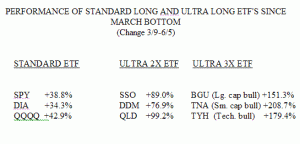It is rare that I complete an analysis whose findings totally surprise me, but take a look at this one. A lot of the pundits claim that the ultra ETF’s, leveraged baskets of stocks that try to double or triple the performance of their underlying indexes or sectors, fail to achieve their goals. So, just to satisfy my curiosity, I compared the performance of the primary index ETF’s, SPY (S&P500) , DIA (Dow 30) and QQQQ (Nasdaq 100) with those of the leveraged ETF’s. There were exact comparisons for these indexes for the 2X ETF’s, but I had to choose other, more general indexes for the 3X ETF’s. The results blew me away…
The 2X and 3X Ultra ETF’s absolutely outperformed the standard index ETF’s in the period since the March bottom. For example, while the QQQQ (Nasdax 100) index ETF rose 42.9% in this period, the QLD (2x QQQQ ETF) rose 99.2% and the TYH (technology bull 3X ETF) rose 179.4%. In comparison, the top five individual stock performers in the Nasdaq 100 stocks rose from 138.8% (JAVA) to 180.57% ( STX). In fact, only 16 stocks (16%) in the Nasdaq100 (and 23% in the S&P500) rose 80% or more. So, the choice before us is to search for the needle in the  haystack individual stock that might do really well in a bull rise, or to buy one of these 2X or 3X ultra long ETF’s and ride a basket of stocks with a lot more diversification and probably less risk than owning individual stocks. The key is to discern the trend accurately and to then ride the ultra ETF with the most potential for following that trend. Some ultra ETF’s also trade options…..
haystack individual stock that might do really well in a bull rise, or to buy one of these 2X or 3X ultra long ETF’s and ride a basket of stocks with a lot more diversification and probably less risk than owning individual stocks. The key is to discern the trend accurately and to then ride the ultra ETF with the most potential for following that trend. Some ultra ETF’s also trade options…..